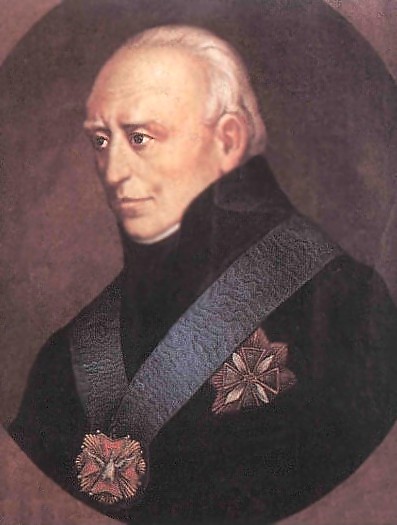- Stanisław Staszic
Infobox Person
name =Stanisław Staszic
image_size =250px
caption =
birth_date =November 6 ,1755
birth_place =Piła
death_date =January 20 ,1826
death_place =Warsaw
occupation =Philosopher and writer
spouse =
parents =
children =Stanisław Staszic (
November 6 ,1755 -January 20 ,1826 ) was a Polishpriest ,philosopher ,statesman ,geologist ,scholar ,poet andwriter , a leader of thePolish Enlightenment , famous for works related to the "Great" or "Four-Year Sejm " (1788-1792) and itsConstitution of May 3, 1791 .Life
Staszic was born into a burgher family in the town of
Piła . He graduated from a Jesuit school inPoznań and became a Catholic priest. Between 1779 and 1781 he continued his theological studies inFrance andGermany . He also spent some time abroad between 1790-1791 and 1794-1797.Due to his burgher origin, he was barred from owning land and holding many official posts in the
Polish-Lithuanian Commonwealth , but due to the friendship ofJózef Wybicki he got a position of a tutor in the house of the great chancellor,Andrzej Zamoyski .Staszic was a strong partisan of reforms and an ardent advocate of the interests of the lower classes, especially the peasants. A physiocrat, monist, pan-Slavist (after 1815) and laissez-fairist, he was a leading supporter of the reforms introduced by the
May Constitution of Poland of 1791. He advocated the abolition of thesecond serfdom and improvements of the peasants fate (by granting them land and private rights). Founded theHrubieszowskie Towarzystwo Rolnicze (Hrubieszów's Agricultural Society) in 1816, the first Polishcooperative .After the
partitions of Poland , he organized mining schools, societies of learning, departments of industry and arts. From 1808 he was director of theSociety of Friends of Learning (orSociety for the Promotion of Learning , Towarzystwo Przyjaciół Nauk), predecessor to thePolish Academy of Sciences (Polska Akademia Nauk). After the fall of theDuchy of Warsaw in 1815, he became a member of the Council of State of the successorCongress Kingdom .He studied and wrote about
geography andgeology , discoveredcoal inDąbrowa Górnicza , where he initiated the building of acoal mine . He was also an active supporter of industrial development in Poland. Between 1816 and 1824, he was "de facto" minister of industry of the Congress Kingdom and began construction of theOld Polish Industrial Area ("Staropolski Okręg Przemysłowy "), with steel and zinc mills aroundKielce andSandomierz .He died in Warsaw in 1826. His testament left his property at
Hrubieszów to its tenants.Awards
* Knight of the
Order of the White Eagle Works
His best-known works include:
* "Remarks upon the Life of
Jan Zamoyski " ("Uwagi nad życiem Jana Zamoyskiego", 1787)
* "Warnings for Poland" (or "Warnings to Poland", "Przestrogi dla Polski", 1790)
* "On the Origin of Mountains in Former Sarmatia and Later Poland" ("O ziemorództwie gór dawnej Sarmacji, potem Polski", 1815)
* "Humankind" ("Ród Ludzki", 1820)
* A Polish translation of Homer'sIliad (1815).Quotes
* "Even a worthy nation can fall, but only a worthless one can perish"
* "People will not work their best until they are [...] owners of their land"See also
*
Friedrich Wilhelm von Reden
*Hugo Kołłątaj
*Piotr Skarga
* History of philosophy in PolandPersondata
NAME= Staszic, Stanisław
ALTERNATIVE NAMES=
SHORT DESCRIPTION=Philosopher and writer
DATE OF BIRTH=November 6 ,1755
PLACE OF BIRTH=Piła
DATE OF DEATH=January 20 ,1826
PLACE OF DEATH=Warsaw
Wikimedia Foundation. 2010.
